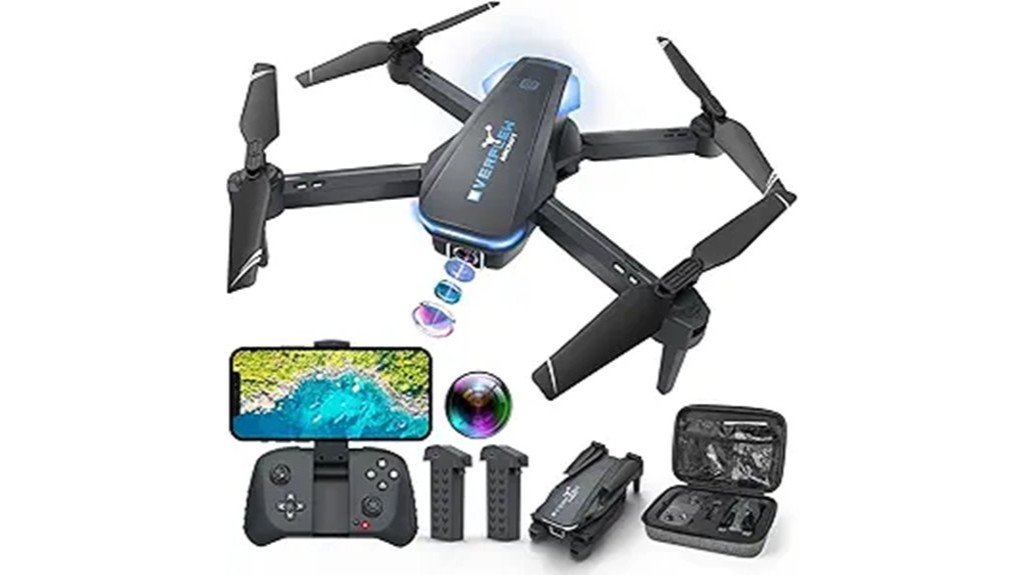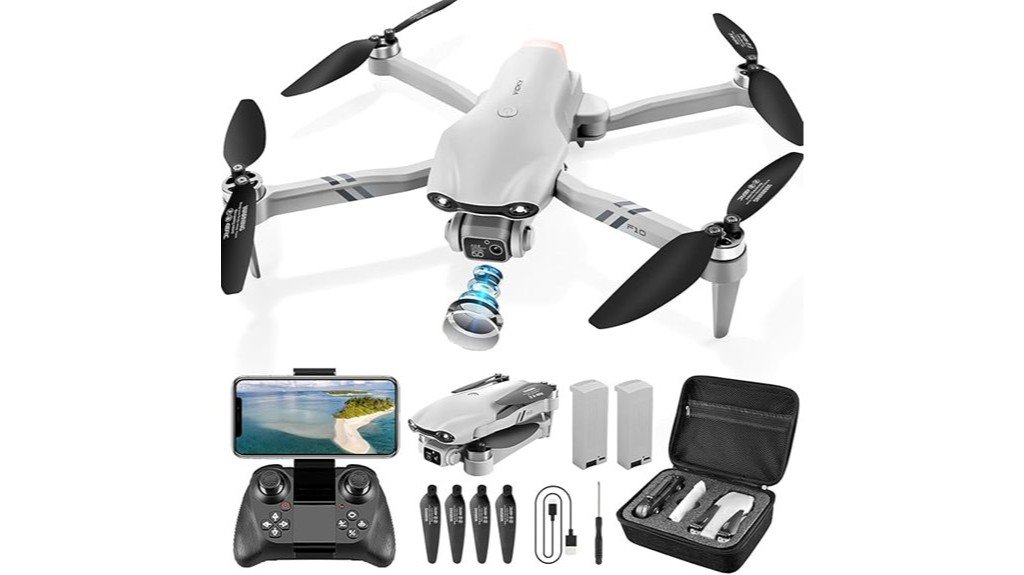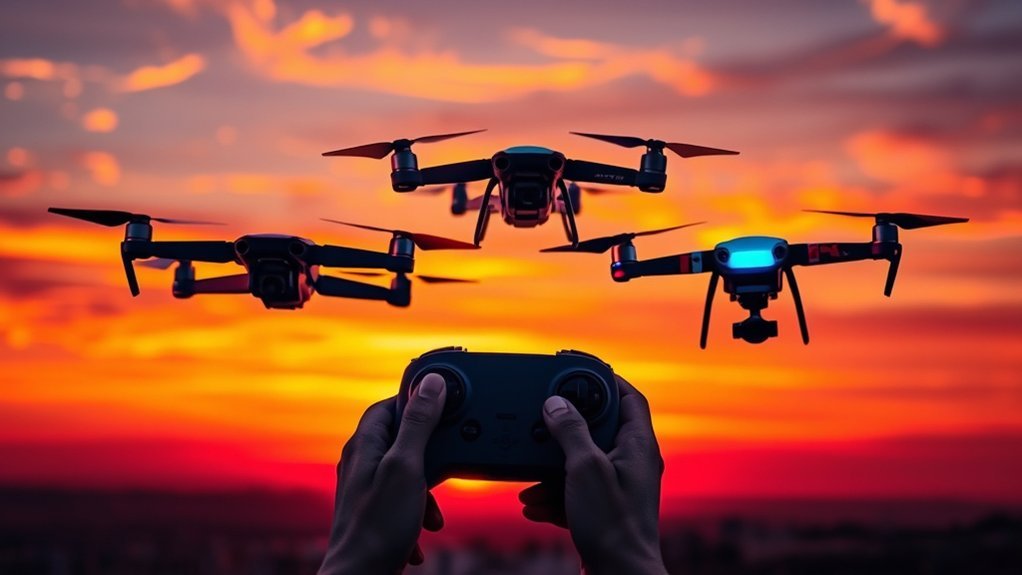If you’re new to flying drones, choosing the right one can be overwhelming. You want something that’s easy to pilot and captures decent footage without breaking the bank. The X1 PROMAX 8K, a 1080P camera drone, and the DRONEEYE F10 are solid options that cater to beginners. Each has unique features that can help you get off the ground quickly and confidently. But which one really suits your needs? Let’s explore these options further.
X1 PROMAX 8K Action Flying Camera Drone

If you’re an adventurer or content creator looking to capture breathtaking footage, the X1 PROMAX 8K Action Flying Camera Drone is an exceptional choice. It’s the world’s first 8K@30fps flying action camera, delivering stunning cinematic-quality videos. With its 104° FOV lens and SmoothCapture 2.0, you’ll enjoy steady shots every time. Plus, its innovative OmniTerrain feature allows you to fly anywhere—over snow, water, or cliffs. The foldable design makes it easy to pack, and handsfree operation means you can get started with just a click or voice command. Experience the thrill of capturing your adventures like never before!
Best For: Adventurers and content creators seeking high-quality aerial footage with advanced features.
Pros:
- Exceptional 8K video quality and cinematic footage with SmoothCapture 2.0 stabilization.
- Versatile flight capabilities with OmniTerrain and numerous automatic flight modes.
- Compact, foldable design makes it portable and easy to travel with.
Cons:
- Battery life is relatively short, lasting only 10-13 minutes per flight.
- Tracking issues may occur in complex environments, affecting performance.
- Some users report potential video stabilization problems in certain conditions.
Drone with 1080P Camera for Beginners and Adults

The Drone with 1080P Camera is an ideal choice for beginners and adults looking to plunge into the world of aerial photography and videography. This foldable quadcopter features voice control, gestures for selfies, and altitude hold, making it user-friendly. With a 1080P camera that captures stunning 1920×1080 pixel videos and stills, you’ll enjoy impressive media quality. You can operate it via remote or the Hiturbo FPV app, enhancing your experience. With a flight time of up to 24 minutes and a maximum range of 0.05 kilometers, it’s perfect for exploring your surroundings while honing your flying skills.
Best For: Beginners and adults interested in aerial photography and videography.
Pros:
- User-friendly features including voice control and gesture selfies enhance the flying experience.
- High-quality 1080P camera with video capture resolution of 1920×1080 pixels for impressive media output.
- Foldable design and lightweight construction make it portable and easy to carry.
Cons:
- Limited flight range of 0.05 kilometers may restrict exploration options.
- Flight time of approximately 12 minutes per battery may require frequent recharging for extended use.
- Requires Wi-Fi connectivity for advanced features, which may not be accessible in all locations.
DRONEEYE F10 Foldable Drone with Camera

For those diving into the world of drones, the DRONEEYE F10 Foldable Drone with Camera stands out with its user-friendly features, making it an excellent choice for beginners. Weighing just 100 grams, it’s lightweight and compact, perfect for easy transport. You’ll appreciate the 1080P HD camera for capturing clear images and videos. With intuitive controls like One Key Start and Altitude Hold, flying becomes effortless. Enjoy various flight modes, including follow and waypoint, enhancing your experience. While some users report mixed camera quality, the overall stability and ease of use make it a solid option for both kids and adults.
Best For: The DRONEEYE F10 Foldable Drone with Camera is best for beginners and casual users looking for an easy-to-operate and portable drone experience.
Pros:
- User-friendly controls, including One Key Start and Altitude Hold, make it ideal for novice pilots.
- Lightweight and foldable design allows for easy transport and storage.
- Multiple flight modes, such as follow and waypoint, enhance flying experiences.
Cons:
- Mixed reviews on camera quality, with some users finding it does not achieve true 1080p clarity.
- Occasional reports of loss of control and malfunction during flight.
- Performance may be affected in windy conditions, limiting usability.
Factors to Consider When Choosing a Drone for Starters
When choosing a drone as a beginner, you’ll want to keep several key factors in mind. Think about your budget, the camera quality you need, and how long you want the battery to last. Also, consider how user-friendly the controls are and if the drone’s design fits your lifestyle for portability.
Budget and Pricing
Setting a budget is essential in your journey to choose the right drone as a beginner. Entry-level drones typically range from $50 to $300, while advanced models can exceed $1,000. If you’re looking for something affordable, many beginner drones with 1080P cameras are available for under $150, perfect for casual users. Keep in mind that cheaper models may offer limited flight time and range, usually around 10-15 minutes and 0.05-120 meters, respectively. Balancing cost with features is vital; advanced drones with capabilities like 8K video come with a higher price tag. Don’t forget to factor in extra costs for accessories, such as additional batteries or protective gear, which can impact your overall investment in the drone experience.
Camera Quality Requirements
Choosing the right camera quality is essential for beginners looking to capture stunning aerial footage. A resolution of at least 1080P is recommended, as it offers clear images and videos without overwhelming you with complicated settings. If you’re aiming for more advanced content, consider drones with higher resolutions, like 8K@30fps, which provide cinematic-quality footage.
Features such as adjustable camera angles and multiple views can enhance your creative possibilities, allowing you to adapt to various filming scenarios. Stability is also key; drones with electronic image stabilization greatly reduce shakiness, improving video quality. Finally, make sure the drone supports popular video formats like MP4 to make editing and sharing your content easier across different platforms.
Flight Time Duration
Flight time duration plays an essential role in your drone experience, especially as a beginner, since it directly impacts your ability to practice and refine your skills. Most drones offer flight times ranging from 10 to 25 minutes, depending on the model and battery capacity. If you choose a drone with a shorter flight time of around 10-13 minutes, you might find yourself frequently recharging, which can interrupt your learning. Opting for drones with dual batteries can extend your flight sessions to about 24 minutes, providing a more enjoyable experience. Keep in mind that environmental factors, like wind and temperature, can also affect your drone’s actual flight time, often reducing it from what’s advertised.
User-Friendly Controls
As you get comfortable with your drone’s flight time, the next important factor to contemplate is how user-friendly the controls are. Look for drones with one-key start and landing functions; these simplify operation and minimize crash risks. Drones featuring altitude hold capabilities allow for stable hovering, making it easier to capture images or videos without constant adjustments. Opt for models with headless mode, which helps you navigate intuitively without worrying about direction. Voice control options can provide hands-free operation, enhancing ease of use further. Finally, consider drones that offer app control, as they often include user-friendly interfaces and guided tutorials, making it simpler for you to learn the ropes and enjoy your flying experience.
Portability and Design
When you’re starting out with drones, portability and design are essential factors to evaluate, especially if you plan to take your drone on adventures. Look for a foldable design; it enhances portability and makes storage easier, perfect for travelers. Consider the weight, too—lighter models are easier to carry and often more maneuverable in the air. A compact size can greatly boost convenience, allowing your drone to fit seamlessly in backpacks or carrying cases. Durability is key, so choose drones made from aerospace-grade composites for structural integrity without the bulk. Don’t forget to check safety features like fully enclosed propellers, which protect your drone during transport and minimize damage risks.

